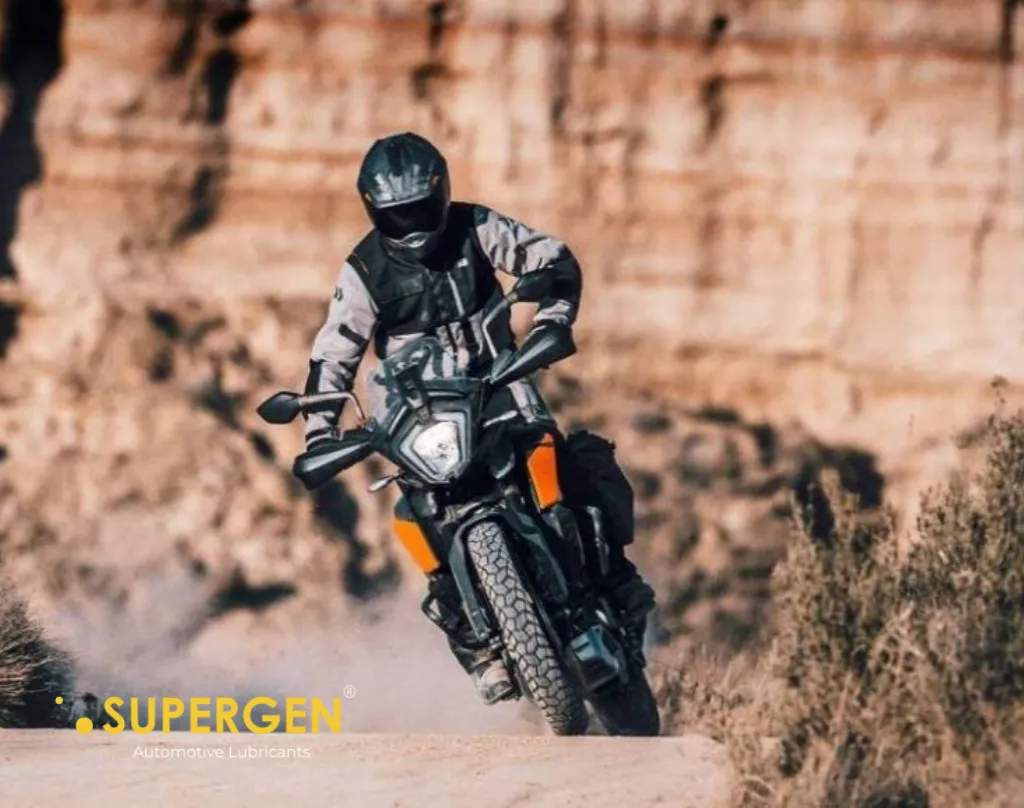Off-road motorcycle riding is an enticing activity for all motorbike enthusiasts in India. It is a thrilling way to explore the great outdoors. However, it is crucial to ensure you take the proper precautions before embarking on your off-roading trip. In a diverse terrain like India, proper knowledge and experience combined with adequate safety measures help to combat the perils and risks of riding your motorbike off-road. This blog delves into the safety tips for all off-road motorbike riders to equip you to enjoy the ride.
Gear Up Properly
Proper protective gear is the bare minimum requirement for off-road riding. At the least, you must wear:
- A well-fitting helmet with a visor or goggles to protect your eyes from debris
- Sturdy, over-the-ankle boots with good grip and ankle support
- Gloves with a firm grip and knuckle protection
- Riding jacket and pants made of abrasion-resistant material with impact protection
Even though riding gear is expensive, the price to pay is much less compared to the price of your life or heavy medical bills in case of a mishap or spill. Riding gear is crucial to saving yourself from severe life-altering injuries in an accident, as it protects your bones and organs.
Prepare Your Bike
Before you head out, you need to ensure your motorcycle is equipped to handle the ride. Check the following:
- Tyre pressure and tread depth – properly inflated tyres are essential for off-road grip.
- Brakes – ensure they are working properly and adjust the lever position so they can be operated with two fingers.
- Engine protection – install a sump guard if your bike doesn’t have one to protect the engine cases.
- Suspension – Check the settings and ensure they function smoothly.
In addition to the above, being prepared for emergencies is essential. Carry important tools and spares, such as a tyre repair kit, spark plugs, and a basic toolkit, in case of mechanical issues on the trail, where you are not able to access a workshop or mechanic.
Master Slow-Speed Manoeuvers
For riding off-road, it is a must to have excellent slow-speed control. You can practice the below manoeuvres in a safe area before embarking on a long journey:
- Clutch control – learn to feather the clutch for smooth, controlled takeoffs and low-speed manoeuvres.
- Turning – practice tight turns by leaning the bike while keeping your body upright and using your inside leg for balance.
- Braking – use both brakes but rely more on the rear brake for controlled stops. Avoid sudden braking to prevent skids.
Mastering these skills allows you to tackle critical sections of the trail confidently and at a speed at which you are comfortable handling your bike. Being prepared beforehand avoids making any risk moves that may go awry.
Stand Up and Move Around
When the terrain gets rough, standing up on the footpegs is always safer. This allows you to absorb impacts through your legs and gives you better control of your bike. You can also shift your weight to the side to control the bike. Here’s how:
- Lean forward when climbing hills to keep the front wheel planted
- Lean back when descending to keep the rear wheel from lifting
- Shift your weight to the outside peg when cornering to help the bike turn
Standing up while riding is no easy feat. It can seem daunting at first, but it’s an essential skill for off-road riding, which can be mastered with practice. Start at slow speeds and gradually increase your pace as you get more comfortable.
Look Ahead and Plan Your Line
Keeping your eyes on the trail ahead is crucial to spot obstacles and plan your route. Scan the terrain for the smoothest, most stable path. Anticipate changes in traction and be ready to adjust your speed and body position accordingly.
If you encounter an obstacle you’re unsure about; you should stop and inspect it before attempting to ride over or around it. Making decisions while moving or in a hurry in critical situations may cause accidents.
Ride Within Your Limits
Even though off-road riding is about having fun and challenging yourself, knowing your limits and riding within them is crucial. You can always dismount and walk through sections you are not confident about riding through. There’s no shame in admitting when the trail is too difficult or technical for your current abilities.
If you find yourself in over your head, staying calm and focused is of the utmost importance. Look for the easiest way to safely navigate the obstacle or find a way to turn around. Panicking and making rash decisions are recipes for disaster.
Ride With a Group
Whenever possible, ride with a group of experienced off-road riders. Having people along with has many advantages:
- You can learn from more skilled riders and pick up new techniques
- If you have a mechanical issue or crash, someone will be there to help
- You can take turns leading and following, allowing you to focus on your own riding
Just be sure to ride at a pace that everyone is comfortable with and communicate clearly about obstacles and hazards ahead.
Stay Alert and Focused
While off-roading, it is crucial to always be at your full attention. Distractions like music or phone calls can be very dangerous. Your complete focus should always be on the trail in front of you. Be aware of your surroundings and hazards like wildlife, fallen trees, or deep ruts.
If you start to feel tired, always take a break. Do not risk riding when you’re tired, as it increases the chances of making mistakes and crashing. Listen to your body and know when to call it a day.
Respect the Environment and Other Riders
Finally, remember that off-road riding is a privilege, not a right. Be responsible by staying on designated routes, avoiding sensitive areas, and do not litter in nature. Respect other riders by giving them the right-of-way and controlling your speed when you pass them.
By following these essential safety tips and riding carefully, you can enjoy the thrill of off-road riding while minimising the risks. Safety should always be your top priority when exploring the great outdoors on two wheels. Happy trails!








